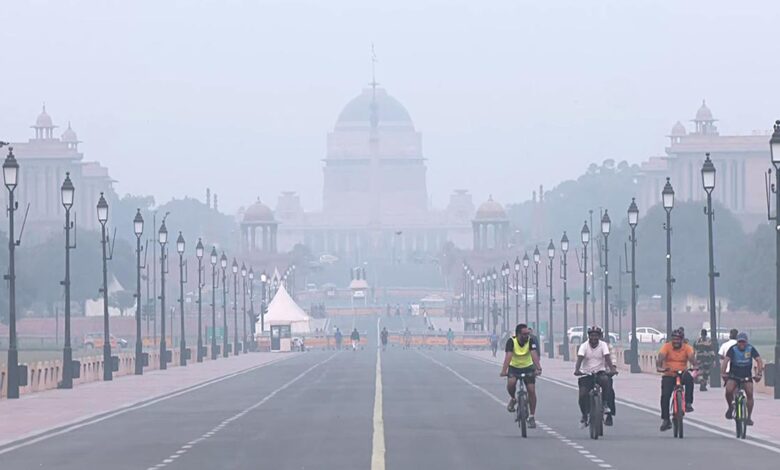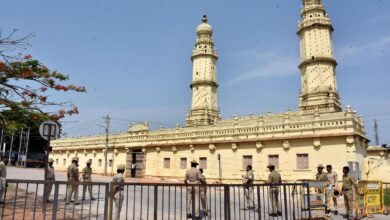Delhi air quality remains ‘very poor’ post Diwali; farm fire fuels rising pollution: CSE report


People cycling at the Kartavya Path near India Gate amid deteriorating air quality, in New Delhi on Saturday (November 2, 2024).
| Photo Credit: ANI
Delhi’s PM2.5 levels hit a peak by midnight on Diwali this year, which was 13% higher than the peaks observed last year and in 2022, a recent analysis by the Centre for Science and Environment (CSE) showed.
“The Diwali night this year had higher nitrogen dioxide (NO2) levels that indicate high traffic congestion,” the CSE report said.
The research organisation’s report also said, unlike previous years, on Diwali night in Delhi, there was a quick buildup of PM2.5 levels and dissipation the next day.
“By midnight on October 31, PM2.5 hit a peak of 603 µg/m³, 13% higher than Diwali peaks observed in 2022 and 2023,” the report stated.
Meanwhile, according to a report by the Delhi Pollution Control Committee (DPCC), the PM2.5 levels decreased by 4% as compared to Diwali last year.
PM2.5 are fine inhalable particles with a diameter that is generally 2.5 micrometres or smaller and are hazardous for health conditions. The acceptable annual standard for PM2.5 is 40 micrograms per cubic metre.
The CSE report said PM2.5 levels were already rising steadily during the preceding five days leading up to Diwali and showed a marked increase of 46% from October 28 through October 31.
“The 12-hour (from 8 pm to 8 am) of PM2.5 concentration on Diwali night in 2024 was 34% higher than Diwali night in October 2022,” it said.
Moreover, PM2.5 levels this year were more than twice as high as the average nighttime pollution recorded over the seven nights before Diwali, the report stated.
However, the unique trend of PM2.5 pollution on Diwali this year was the “sudden sharp increase at night and also quicker dissipation the day after”, it said.
The PM2.5 was in the poor category during the afternoon of October 31, but the evening build-up peaked to hit severe levels during midnight and stayed elevated until early morning the next day, the report mentioned.
“This time the dissipation has occurred quicker compared to previous years — not lasting as a smog episode (that is remaining elevated at severe level for at least three consecutive days). It came down to more moderate levels of 97 µg/m³ by noon,” the report said.
“The reasons behind this late build-up and early dissipation of pollution on Diwali day were warm atmospheric conditions with relatively more efficient natural ventilation and adequate wind in the city. This is supposed to be one of the warmest October this year,” it said.
The report said this year, nine out of 38 air quality monitoring stations recorded PM2.5 concentrations exceeding the critical threshold of 900 µg/m³ on Diwali night.
The highest levels were observed at Nehru Nagar at 994 µg/m³, followed closely by Anand Vihar at 992 µg/m³, Pusa IMD at 985 µg/m³, Wazirpur at 980 µg/m³, and JLN Stadium at 963 µg/m³. Other affected areas are Okhla, CRRI-Mathura Road, Karni Singh Stadium, Lodi Road, Siri Fort, etc., the report said.
The report further said, “There was sudden and sharp escalation in farm fire count on the day of Diwali and that combined with the change of wind direction to north westerly. This increased the share of its contribution to Delhi’s air quality by 27 per cent.”
According to data from the Indian Agricultural Research Institute (IARI), the farm fire count had increased from 60 on October 30 to 605 on October 31, the report said.
“Punjab accounted for the highest share of farm fire incidents at 80%, followed by Uttar Pradesh at 13%, and Haryana at 7%,” the report said.
As per the report, Diwali night this year had higher NO2 levels compared to last year. The NO2 level in the last three years has been higher on Diwali night and also the nights preceding it, which is indicative of congestion and high traffic conditions in the city leading to the festival night, it said.
“ITO had highest NO2 levels in the city with night-time average of 182 µg/m³, while JLN Stadium 104 µg/m³ and Patparganj with 101 µg/m³ were the other NO2 hotspot on Diwali night. Lodhi Road with just 2 µg/m³ of NO2 was the least affected area in the city,” it said.
Published – November 03, 2024 08:08 am IST






